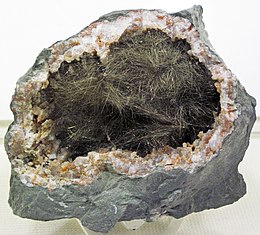Nickel(II) sulfide
| Millerite | |
|---|---|
 |
|
| General | |
| Category | Sulfide mineral |
|
Formula (repeating unit) |
NiS |
| Strunz classification | 2.CC.20 |
| Crystal system | Trigonal |
| Crystal class | Ditrigonal pyramidal (3m) (same H-M symbol) |
| Space group | R3m |
| Unit cell | a = 9.607 Å, c = 3.143 Å; Z = 9 |
| Identification | |
| Colour | Pale brass-yellow to bronze-yellow, tarnishes to iridescence |
| Crystal habit | Typically acicular (needle-like) often in radial sprays - also massive |
| Cleavage | Perfect on {1011} and {0112} - obscured by typical form |
| Fracture | Uneven |
| Tenacity | Brittle; capillary crystals elastic |
| Mohs scale hardness | 3 - 3.5 |
| Luster | Metallic |
| Streak | Greenish black |
| Diaphaneity | Opaque |
| Specific gravity | 5.3 - 5.5 |
| Other characteristics | brittle and becomes magnetic on heating |
| References | |
Millerite is a nickel sulfide mineral, NiS. It is brassy in colour and has an acicular habit, often forming radiating masses and furry aggregates. It can be distinguished from pentlandite by crystal habit, its duller colour, and general lack of association with pyrite or pyrrhotite.
Millerite is a common metamorphic mineral replacing pentlandite within serpentinite ultramafics. It is formed in this way by removal of sulfur from pentlandite or other nickeliferous sulfide minerals during metamorphism or metasomatism.
Millerite is also formed from sulfur poor olivine cumulates by nucleation. Millerite is thought to form from sulfur and nickel which exist in pristine olivine in trace amounts, and which are driven out of the olivine during metamorphic processes. Magmatic olivine generally has up to ~4000 ppm Ni and up to 2500 ppm S within the crystal lattice, as contaminants and substituting for other transition metals with similar ionic radii (Fe2+ and Mn2+).
During metamorphism, sulfur and nickel within the olivine lattice are reconstituted into metamorphic sulfide minerals, chiefly millerite, during serpentinization and talc carbonate alteration. When metamorphic olivine is produced, the propensity for this mineral to resorb sulfur, and for the sulfur to be removed via the concomittant loss of volatiles from the serpentinite, tends to lower sulfur fugacity.
This forms disseminated needle like millerite crystals dispersed throughout the rock mass.
Millerite may be associated with heazlewoodite and is considered a transitional stage in the metamorphic production of heazlewoodite via the above process.
...
Wikipedia
